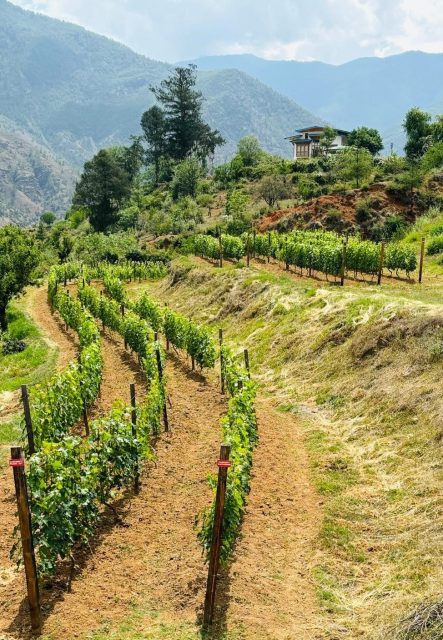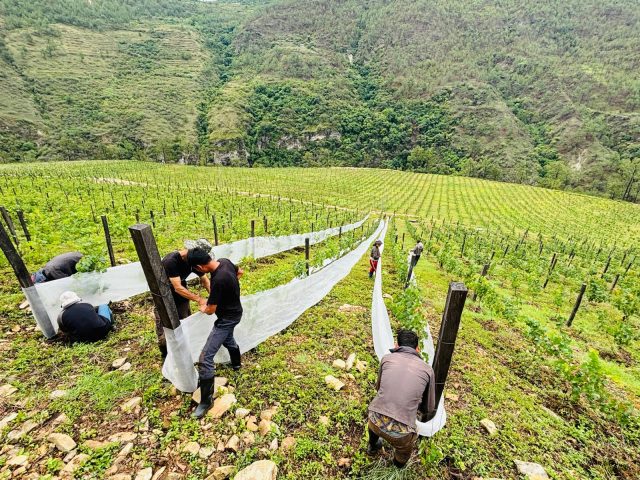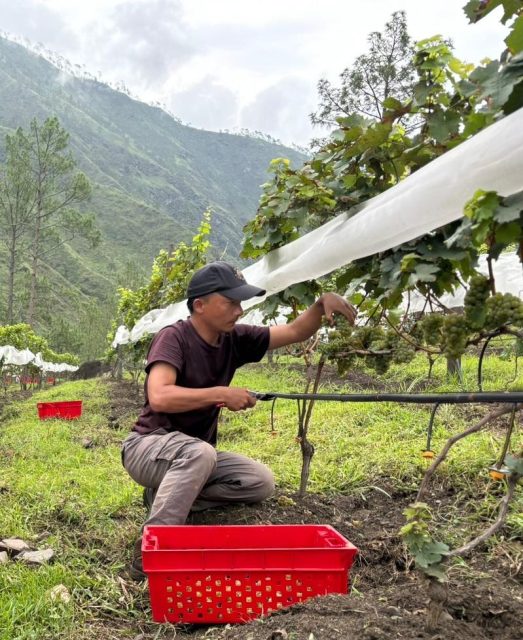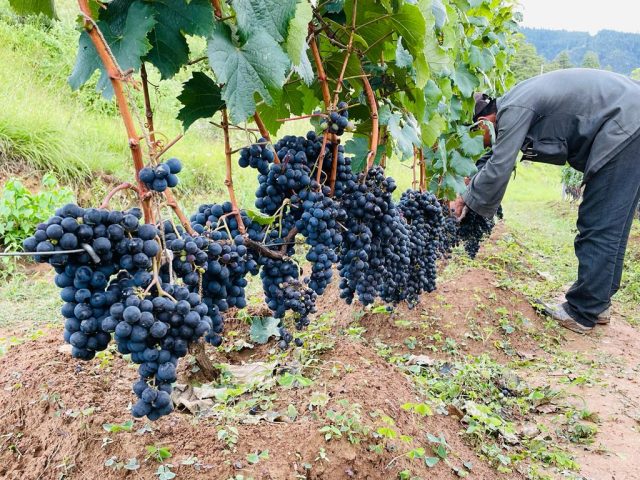Will Bhutan be the world’s next great wine region?
By Kathleen WillcoxKathleen Willcox wonders if Bhutan could become the world’s next great wine region as climate change, economic realities and shifting tastes upend accepted assumptions about what is possible in the world of wine.

The idea of making wine high in the Himalayas may seem far-fetched, but rising global temperatures and unpredictable weather are making the mid-latitude regions where wine production used to always occur decidedly less hospitable to delicate grapes.
Up to 70% of all current wine-producing regions may be wholly unsuitable for growing grapes if temperatures continue to increase apace, with 90% of coastal and lowland regions of Spain, Italy, Greece and Southern California “at risk of disappearing,” according to a review of more than 200 studies published in Nature Reviews Earth & Environment.
But why Bhutan?
“Why not Bhutan?” rejoins Michael Juergens, a partner at Deloitte, where he leads the Deloitte WInery SOlutions and Services practices. Juergens’ passion for and focused research on the potential of Bhutan’s terroir for making great wine ultimately helped him persuade his partner Ann Cross into leave her post marketing Disney princesses as a brand consultant at Mattel to take the helm as CEO of the Bhutan Wine Company.
To be clear, no one has ever made wine from grapes in Bhutan, despite thousands of years of rich civilization and the country’s long tradition of top-notch fruit farming.
“We really couldn’t not take this opportunity when it appeared,” Juergens continues. “Who doesn’t want to build something from scratch? And the country’s incredible diversity of micro-climates, elevations and soils, the purity of the environment and the government’s support of the initiative made the venture completely irresistible to both of us. Just think of the possibilities!”

A bird’s eye view of Bhutan
If you can’t quite recall where Bhutan is, you’re not alone. Juergens himself admits that he thought it was an island somewhere off the coast of Asia.
The Asia part is correct, but Bhutan is actually landlocked, and perched on the eastern ridges of the Himalayas in south-central Asia. Bhutan was historically a remote kingdom, never having been a stop on the Silk Road, or subject to a Roman invasion. Until the 1960s, the main way of life was herding yaks and sharing the spices, grains and diversity of fruits the small country is capable of cultivating. There wasn’t even an official form of currency until the 60’s, but since then, the economy has evolved, in its own unique way, given its remoteness. It is still a largely agrarian society, with about 95 percent of its populace participating in the farming industry.
“Bhutan is just 14,000 square miles and about 300 miles north to south, but it is incredibly diverse despite its small size,” Juergens says, likening it to the great wine-growing nations of France and Portugal, each of which offers terrains that allow for wildly divergent wine styles. “The climate changes considerably with elevations and soils, but there are three main climactic regions.”
The Duars Plains are hot and subtropical; the Lesser Himalayas are cooler and more temperate; the Great Himalayas offer alpine tundra. Depending upon where you are, you might see pine or oak, walnut or juniper, shrubs and grass; watch out for the rhinos, elephants and Bengal tigers.
Visitors only really began arriving to Bhutan in the 1970s, and they remain — cautiously — open to outsiders, for a fee. Since 1974, the Royal Government of Bhutan has focused on a “High Value, Low Impact” tourism scheme designed to preserve its rich cultural heritage and its status as the world’s only carbon negative country, a status surely also boosted by the constitutional mandate to keep at least 60% of its land forested.
The remote charm of Bhutan has been attracting a certain type of adventurous, idiosyncratic Western traveler for decades. And in fact, the Bhutan Wine Company – from its existence to its highly ambitious mission – would not exist without Jamie Zeppa, who was so inspired by her time there, she wrote a book about it that landed in Cross’ hands.
Her 2000 memoir, Beyond the Sky and the Earth: A Journey Into Bhutan, struck a chord with Cross, who says she’s been keen to explore Bhutan for years.
“When I found out there was going to be a marathon there, I knew we needed to get there,” Cross recalls. “For years, Mike and I had been combining our love of running, wine and travel by organizing vacations around doing marathons in wine regions. When we got there, we were surprised to learn that not only was there no wine being produced there, there had never been any wine produced there.”
The pair fell hard for the people, the bountiful agriculture and the diverse climates of Bhutan, and they shared their shock at the seeming oversight– why no vino? – with the various business and government officials attending a cocktail party following the marathon they ran while visiting.
“I couldn’t resist sharing the fact that I thought there was an enormous missed opportunity,” Juergens recalls. “I basically said, ‘you guys are fucking this up.’ It was casual cocktail conversation, but I just said, ‘look, if you can grow the best tangerine and guava I’ve ever tasted, you can grow grapes.’ The pure air, biodiversity, the high elevations and diversity of terroirs, the microplastic-free water, it’s a recipe for great wine.”
When they came back home, Juergens, who was also studying for his M.W. (both hold various impressive wine education and knowledge too numerous to list, but the Master of Wine title remains stubbornly elusive, for now) in his “spare” time, decided to issue a white paper on the promise of the terroir in Bhutan.

An idea coalesces
Juergens sent the white paper, which he spent about six months researching, detailing a 10-year-vision for how Bhutan would build a sustainable, world-class wine region in the Himalayas, from grape to glass, off into the ether.
“I never thought I’d actually be involved,” he says. “I just wanted to see it get done. I never heard back.”
That was that, he thought.
Partner Content
But one of the people he passed the white paper to, Bill Fischer, took Juergens’ vision as seriously as he did.
“Ann and I decided to return to Bhutan for a second time in 2018 for another marathon, and when we got there, I kept getting requests for meetings from government officials and business entrepreneurs,” Juergens says. “Bill was one of the marathon organizers, and he was very well-connected in Bhutan. Behind the scenes, he’d drummed up a lot of interest in the project.”
One thing led to another, and by the end of the year, he had persuaded Cross to co-found the Bhutan Wine Company, and in fact transition to a full-time job there as CEO. (He is still a partner at Deloitte). Fischer is an equity investor. The government of Bhutan had agreed to support the project through free land for vineyards, scientific support and consultations with agricultural research stations.

A vision transformed into a product
Transforming a vision for a thriving wine region in the land of yaks and cardamom into a line of marketable products that people will be excited to drink requires, to put it succinctly if rather vaguely, a lot.
Here’s how it’s gone: the first vineyards were planted in 2019, and planting continues apace, all over the country.
“We are trying to compact a century of education into a decade,” says Juergens. “So we have planted several experimental vineyards, three commercial vineyards are in, with two more to go. We have about 17 varieties planted, and we are trying to see what works where, by spreading ourselves across the country and failing fast so we can eventually soar.”
The vineyards cover the entire country, covering climates from cool to moderate to warm, and range in altitude (reaching up to 9,150 feet in elevation).
“In Bhutan they are very good at growing fruit, and we are benefiting so much from their expertise,” Juergens says. “We want to do it safely and sustainably, because the country is so pristine, but the Bhutanese government is as excited as we are at the prospect of building out a wine region that they can hang their hat on.”
The ambition is enormous.
“We hope to have 2,000 acres under vine soon, with the goal of producing 360,000 cases of wine, primarily for export,” Juergens says. “Our goal is to reflect not just the terroir of Bhutan, but its identity and culture, which means quality over quantity.”
But the wine industry moves slowly for a reason.
It takes years of patience and planning for a vineyard to be mature enough to harvest for wine that anyone would want to put in their mouth and swallow.
In Bhutan, with its lack of viticultural infrastructure, it’s even more daunting. All equipment and material has to be shipped in from Europe or the Americas, which takes 45 to 60 days on the ocean, then 4-6 on land, under the best circumstances.
“The Gaza war shut down the Suez Canal, and during COVID a ship capsized in the Suez Canal,” Juergens says. “We try to visit when we can, but of course we couldn’t during the pandemic. Our winemaker Matt [Brain] lives there thankfully, which helps, and we have a team of 32 full-time employees.”
This year, grapes were harvested from the first 20 acres of producing vineyards, making Bhutan the second country in 150 years (the first was New Zealand) to launch a new wine industry.
The historic 2023 vintage is a commemorative blend of grapes from four different vineyards. Just one barrel with the blend of six red and four white was made. Juergens declined to name the grapes that made it to the final blend, but a range of classic – from Cabernet Sauvignon to Tempranillo, Sauvignon Blanc and Riesling – vinifera dominate their plantings.
This initial wine is designed to be a collector’s piece and memo to the future, rather than a true foray into production for commercial consumption, or a precise promise of what’s to come.
This is the first step on a long journey, Juergens says.
“Our dream is to create something utterly new and unique,” Juergens says. “We currently have Bhutanese oak barrels that we’re testing out. We want Bhutan grapes, wild Bhutanese yeast, Bhutan oak, wine aged at a great altitude in the Himalayas. But it takes time. It has taken us five years to season and prepare the barrels.”
But if the vision succeeds, it will result in a complete, full-circle expression of Bhutan terroir. A first for Bhutan, but also the world.
Related news
The winemaking nations hit hardest by Trump tariffs
Hospices de Nuits-Saint-Georges auction: bucking the trend
‘Liberation Day’ or liquor lockdown? Trump’s tariffs rattle the wine & spirits world




